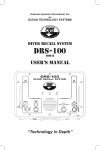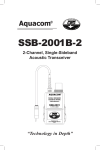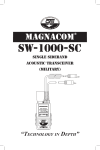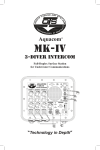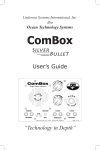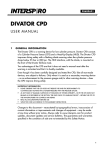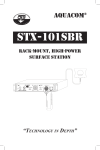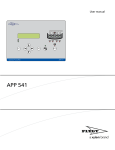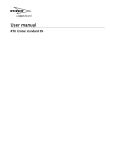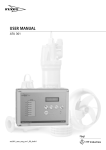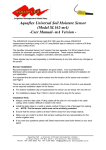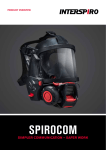Download Aquacom® MK-7 Buddy-Line User Guide
Transcript
MK-7 BUDDY-LINE Two-Diver Intercom User Guide “Technology in Depth” - NOTICE This manual and the information contained herein are provided for use as a maintenance and operation guide. No license or rights to manufacture, produce, and/or sell either the manual or articles described herein are given. Undersea Systems International, Inc., dba Ocean Technology Systems hereinafter referred to as OTS, reserves the right to change specifications without notice. It is recommended that all users read and fully understand this manual before using the MK-7 Buddy-Line. All statements, technical information, and recommendations herein are based on tests we believe to be reliable, but the accuracy or completeness thereof is not guaranteed; and the following is made in lieu of all warranties, expressed or implied, including the implied warranties of merchantability and fitness for purpose: Seller’s and Manufacturer’s only obligation shall be to replace such quantity of the product proved to be defective. Before using, the user shall determine the suitability of the product for intended use, and the user assumes all risk and liability whatsoever in connection therewith. Neither Seller nor Manufacturer shall be liable either in tort or in contract for any loss or damage—direct, incidental, or consequential—arising from the use of or the inability to use the product. No statement or recommendation not contained herein shall have any force or effect unless it is in an agreement signed by officers of the Seller and Manufacturer. - IMPORTANT SAFETY NOTICE (Please read before using product.) It is absolutely essential that all divers are properly trained and equipped and fully understand this user’s manual before attempting to use the Aquacom® MK-7 Buddy-Line. While the Aquacom® MK-7 Buddy-Line provides divers good underwater communications, it does not change or eliminate the potential hazards of diving! Refer to the Library page of our Web site, www.otscomm.com, for a list of any changes made to this manual since its publication. © Copyright 2014 by Undersea Systems International, Inc. dba Ocean Technology Systems. All rights reserved. Specifications are subject to change without prior notice. P/N 506018-002 A i TABLE OF CONTENTS Section Title Page 1Introduction.........................................................................................1 2 Specifications......................................................................................2 3 Functions & Features..........................................................................3 3.1Functions..................................................................................3 3.2Features....................................................................................4 4Operation............................................................................................6 4.1 Setup for the Tender.................................................................6 4.2 Setup for the Diver(s)...............................................................6 5Batteries............................................................................................10 6Troubleshooting................................................................................11 7Maintenance......................................................................................12 8 Helpful Hints....................................................................................13 Warranty Information........................................................................................14 Important Safety Notes ............................................................... i, 3–4, 8, 12, 13 SECTION 1 INTRODUCTION Congratulations! You have just purchased the finest, state-of-the-art hard-wire intercom in the world. Your new MK-7 Buddy-Line two-diver air intercom represents state-of-the-art technology and innovation—the choice of discriminating divers throughout the world. Please take the time to read this user guide. With proper care and use, your OTS product will provide you with the ultimate in high-quality communications and reliability. The MK-7 Buddy-Line is a compact, self-contained two-diver air intercom providing clear communications between the operator and diver(s). The MK-7 Buddy-Line offers four-wire (round-robin or open-microphone) type communications. This manual will cover specifications, operating instructions, four-wire communications, batteries, helpful hints, and warranty information. These guidelines and illustrations are presented to assist you. If you need additional information, do not hesitate to confer with your local OTS dealer or representative. If you require service, contact us: Undersea Systems International, Inc., dba Ocean Technology Systems 3133 W. Harvard Street, Santa Ana, California, 92704 USA Toll-Free: (800) 550-1984 • Tel.: (714) 754-7848 • Fax: (714) 966-1639 E-mail: [email protected] World Wide Web: http://www.otscomm.com 1 SECTION 2 SPECIFICATIONS Input Voltage: 12 VDC Input Current: 600 mA peak Idle Current: 30 mA Frequency Response: 600 Hz to 10 kHz Microphone Type: Dynamic Power Output: 2 watts RMS Battery Type: Eight AA alkaline batteries Battery Life: 12 hours (normal use) using eight AA alkaline batteries Housing: Injection-molded, high-impact plastic Size: Height: 6.750 inches from bottom to top of connector Width: 4.250 inches from latch to latch Depth: 2.750 inches from front knob to rear buckle Weight: 1.0 pounds, without batteries ComCable/ComRope: Up to 1200 feet 2 SECTION 3 FUNCTIONS & FEATURES 3.1 FUNCTIONS The MK-7 Buddy-Line hard-wire system utilizes the “four-wire” approach. It is a closed loop comparable to a telephone system. A typical hard-wire system consists of a surface intercom, a headset with a boom microphone, a ComRope (set up for four wires, shielded or true spiral four), a diver microphone-earphone assembly, a mask microphone, and some sort of diving mask with accommodations for a microphone. The Interspiro Divator MKII “AGA” full-face mask (FFM) is what most professionals prefer, according to our statistics. A hard-wire system requires a physical connection (i.e., umbilical/ComRope) between the listener and talker. The signal travels over the communication ComRope. Most hard-wire intercoms can be configured for either two- or four-wire operations. Four-wire communications is defined as a duplex communication route. Two wires provide the uplink signal path, and two additional wires provide the downlink path. Thus everyone can be online simultaneously (similarly to a telephone conference call). Since the diver is never cut off the diver while talking, as is the case with a two-wire system, the four-wire system is the safer of the two configurations. Due to the increased efficiency achieved with a four-wire system (duplex) and its simplicity of use, the MK-7 is designed for four-wire operation only. The standard MK-7 configuration functions as follows: After the system is powered up and all connections are properly made, the tender’s speech is picked up by the boom microphone located on the headset. The voice is amplified by the upper electronics module and routed through the ComRope. Connected to the ComRope at the diver’s end is the earphone-microphone assembly (typically an EM-OTS-2 for the new Guardian FFM or EMA-2 for the Interspiro FFM). The tender’s speech is reproduced by the earphone part of the assembly. When the diver speaks, his voice is picked up by the mask microphone located inside the mask being used. The voice is routed through the ComRope, received by the upper electronic module, amplified, and then routed to the tender’s headset. If a second diver is on-line, he will hear and talk as well in the same manner. The volume of the tender and diver(s) is controlled by separate volume controls on the outside of the upper electronics module. - IMPORTANT SAFETY NOTES It is extremely important that the divers are dressed out in a manner that will strain-relieve the ComRope. Commercial dive schools typically instruct students to have the ComRope tethered to the diver’s harness or buoyancy compensator with a quick release. If someone pulls on the ComRope and the diver loses control of the ComRope, the pull is on the harness, not on the diver’s mask. This setup prevents accidental removal of the diver’s mask. 3 Additionally, the divers should be dressed out to allow a quick disconnect from the ComRope to allow for a situation where a diver must free himself from the ComRope. In the event divers and the surface tender lose voice communications, both should have in place a back-up rope-pull system for communication. See Table 1 (p. 9) for the line-pull system recommended by OTS. 3.2FEATURES See Figures 1 and 2 for an exploded view of the MK-7 Buddy Line system. Note: The ComRope can be set up for many types of diving masks and/or earphone-microphone assemblies. If you are not sure what to order, consult an OTS dealer or OTS directly for the configuration you require. 1. 2. 3. 4. 5. 6. 7. 8. Headset with boom microphone Noise-canceling boom microphone Female Amp connector Record-out plug (male mini, line level) Small o-ring Male Amp connector Gripper ring Female Amp connector (for ComRope) 9. Upper electronics module 10.Tender volume control 11.Diver 1 and Diver 2 volume controls 12.Housing’s large o-ring 13.Battery pack contacts (copper plating) 14.Eight-cell battery pack (SCB-1) 15.Stainless steel latch 16.Lower housing (battery compartment) FIGURE 1: MK-7 Buddy-Line 4 Ear-Microphone Assembly ComRope Assembly 17.Male Amp connector (ComRope) 18.ComRope Assembly 19.Hi-USE® connector (goes to ComRope) 20.Hi-USE® connector (goes to diving mask) 21.EMA-2 ear-microphone assembly for AGA FIGURE 2: ComRope & EMA-2 assemblies 5 SECTION 4 OPERATION Before operating the MK-7, make certain the batteries are fresh (see Section 5, Batteries). Ensure that all o-rings are in place and free of debris or foreign matter. Verify that all connections are securely fastened. Ensure the divers are dressed in such a manner that the umbilical/ComRope will not snag. These procedures should be performed before each dive. After you have completed the above steps, proceed as follows: 4.1 SETUP FOR THE TENDER 4.1.1 Place the headset with boom microphone on your head so the two earphones are comfortably over your ears and the boom microphone is within 1/4 inch of your lips. 4.1.2 Connect the headset’s Amp connector to the upper electronics module’s Amp connector (Fig. 1, #3 & 6). 4.1.3 Locate the Amp connector on the ComRope, and mate it to the Amp connector located on the top of the electronics module (Fig. 1, #8 and Fig. 2, #17). If there is a second diver, do the same for his connection. 4.1.4 Secure the MK-7 to your belt (or wherever is most comfortable) by using the belt clip located on the back of the upper module. Note: We recommend that the MK-7 main module have some sort of strain relief at the tender’s end to keep the diver and/or ComRope from putting excess strain on the connectors. Excess strain on the connectors would cause damage to the MK-7 and/or loss of communications. 4.2 SETUP FOR THE DIVER(S) 4.2.1 Although the MK-7 Buddy-Line can be used with various full-face or mouth masks, the mask most commonly chosen is the Interspiro Divator MKII (“AGA”) full-face mask (FFM). The following are the setup procedures, if you have an AGA FFM. You should have already connected the headset and ComRopes if you are following this manual (see Section 4.1, Setup for the Tender). We are also assuming you ordered and have the ComRope set up for four-wire communications with a male Amp connector on one end and a Hi-USE® connector on the other end. 4.2.2. The AGA FFM should already have the EMA-2 earphone-microphone assembly installed. If not, install it per the installation instruction sheet provided with the EMA-2. 6 4.2.3. Locate the Hi-USE® connector on the ComRope, and connect it to the HiUSE® connector on the EMA-2 (Fig. 2, #19 & 20). Ensure the Hi-USE® connectors are free of debris and lightly lubricated with a high-grade silicone grease. 4.2.4 Strain-relieve the ComRope in two places on the diver’s end. The first point should have some sort of “D-ring” heavily taped or tied about 4 feet from the Hi-USE® connector. This “D-ring” will be clipped onto the diver’s harness or buoyancy compensator via a carabiner or some good-quality quick-disconnector. This connection will help prevent the ComRope from pulling on the diver’s full-face mask (Figure 3). 4.2.5 The diver should hand-hold the ComRope about 10 feet from the Hi-USE® connector (Figure 3). The diver will now be secured to his harness or buoyancy compensator and have a hand-hold during the dive. The diver should have control of the ComRope throughout the dive. He should feel what is going on, giving topside directions when slack needs to be taken up or when more rope needs to be paid out. If the diver lets go of the hand-hold, the carabiner–D-ring combination will absorb the tension. In the event the diver must break loose of the ComRope totally (i.e., in an emergency), the diver should let go of the ComRope hand-hold and unsnap the device holding the D-ring. The diver then should let topside know what is going on before he detaches the Hi-USE® connectors. The diver then should proceed directly to the surface and reestablish communications (see the notes on page 8). 4.2.6. The tender should ensure the ComRope on his end is also strain-relieved in some manner. This will prevent the diver or topside tender from pulling on the connections made on the MK-7 Buddy-Line electronics module. Carabiner Hand Hold 10 feet from Connector This End Towards Tender D-Ring FIGURE 3: Recommended Setup of the Diver ComRope 7 4.2.7 After all connections are made, you can test the system. Have the diver(s) don the full-face mask. The tender will don the headset with boom microphone. The boom microphone should be positioned 1/4 inch from the tender’s lips (keep the microphone as dry as possible). The MK-7 Buddy-Line will power up the moment the headset and boom microphone are connected. There is no on/off switch. As long as the headset is plugged in, the MK-7 will be on and drawing power. The tender controls all volumes. The volume control labeled “Tender” controls the volume of the tender’s voice to both divers. The individual volume controls labeled “Divers” control what the tender hears from each diver. The tender should adjust all volumes a little at a time until everyone can hear well. Rotating any control clockwise brings the volume up. Counterclockwise rotation brings the volume down. - NOTE 1. If the diver is set up properly, the tender’s pulling on the ComRope should pull on the diver’s hand-hold first. If the diver does not have the hand-hold, the strain should go to the belt “D-ring,” not the diver’s full-face mask or diver’s earphone-microphone assembly. Ensure the diver is dressed out such that no unnecessary loops can entangle him. 2. Excessive volume will cause distortion and hinder communications. Adjust all volumes slowly until everyone hears clearly. A good rule to follow is “Less volume is better than too much noise.” - IMPORTANT SAFETY NOTES 1. The diver should be dressed in such a manner that he can disconnect from the ComRope and from the earphone-microphone assembly. If it becomes necessary to make an emergency ascent, if the diver has to break voice communications, and if line pulls cannot be established, the diver should surface and establish communications as soon as possible. 2. We do not recommend you rely solely on MK-7 Buddy-Line voice communications. A back-up safeguard, such as line pulls, should be established and practiced (Table 1). - NO POWER! If you connect the headset with boom microphone and the MK-7 does not power up, verify the batteries are fresh (new). 8 Table 1: Recommended Line-Pull Signals Source: U.S. Navy Diving Manual From Tender to Diver Searching Signals (Without Circling Line) 1 Pull “Are you all right?” When diver is descending, one pull means “Stop.” 7 Pulls “Go on (or off) searching signals.” 2 Pulls “Going down.” During ascent, two pulls mean “You have come up too far; go back down until we stop you.” 1 Pull “Stop and search where you are.” 3 Pulls “Stand by to come up.” 2 Pulls “Move directly away from the tender if given slack; move toward the tender if strain is taken on the life line.” 4 Pulls “Come up.” 3 Pulls “Face your umbilical, take a strain, move right.” 2-1 Pulls “I understand” or “Talk to me.” 4 Pulls “Face your umbilical, take a strain, move left.” 3-2 Pulls “Ventilate.” 4-3 Pulls “Circulate.” From Diver to Tender Searching Signals (With Circling Line) 1 Pull “I am all right.” When descending, one pull means “Stop” or “I am on the bottom.” 7 Pulls Same 2 Pulls “Lower” or “Give me slack.” 1 Pull Same 3 Pulls “Take up my slack.” 2 Pulls” Move away from the weight.” 4 Pulls “Haul me up.” 3 Pulls “Face the weight and go right.” 2-1 Pulls “I understand” or “Talk to me.” 4 Pulls “Face the weight and go left.” 3-2 Pulls “More air.” 4-3 Pulls “Less air.” Special Signals from the Diver Emergency Signals from the Diver 1-2-3 Pulls “Send me a square mark.” 2-2-2 Pulls “I am fouled and need the assistance of another diver.” 5 Pulls “Send me a line.” 3-3-3 Pulls “I am fouled but can clear myself.” 2-1-2 Pulls “Send me a slate.” 4-4-4 Pulls “Haul me up immediately.” All emergency signals should be answered as given except 4-4-4. 9 SECTION 5 BATTERIES An SCB-1 eight-cell AA battery pack (Fig. 1, #14, on p. 4) is provided with the MK-7 Buddy-Line and is located in the lower housing (Fig. 1, #16). The SCB-1 battery pack consists of an assembled SP-8 battery holder, foam spacer, and contact PCB. Install eight AA alkaline batteries into the SCB-1 battery pack as follows: 1. Locate the latches on the sides of the lower housing (Fig. 1, #15). Pull up on the latches simultaneously. 2. Separate the upper and lower modules while being careful not to damage the o-ring or battery pack contacts (Fig. 1, #12 & 13). 3. Remove the SCB-1 eight-cell battery pack (Fig. 1, #14) and install eight fresh, 1.5-volt alkaline AA batteries per the diagram on the SCB-1. 4. Verify that the o-ring (Fig. 1, #12) is in place, lightly lubricated with a highgrade silicone grease, and free of debris. 5. Align the SCB-1 contacts to the right when looking through front of lower housing. Insert the SCB-1 battery pack into the lower housing. Carefully mate the upper and lower housings together. Ensure that nothing is on the o-ring or mating surface. 6. Connect the latches from the lower housing to the upper strikes. Pull down the latches simultaneously until fully down. This will spring-load the upper and lower assemblies. 7. Look all around the MK-7 to verify the upper and lower assemblies appear evenly attached with no high spots. 10 SECTION 6 TROUBLESHOOTING Should you encounter a problem with the MK-7 Buddy Line, follow the remedies suggested in Table 2. Table 2: Problem, Probable Cause, and Remedy Problem Corrosion buildup on the connectors. Possible Cause Remedy Failure to wash and lubricate connectors after use in salt water. Remove salt water residue or corrosion from the unit by wiping it with a cloth saturated in warm freshwater (use detergent if necessary). Periodically check the connectors to ensure they are clean and lightly lubricated with a highgrade silicone grease. Poor or no Batteries are defective communications. or dead. Replace alkaline AA batteries with fresh ones. Connectors are not properly connected or are damaged. Clean and check all connectors. Replace damaged ones. Headset with boom microphone is not plugged in. Connect headset; unit should power up. Diver(s) cannot hear topside, but topside can hear divers. Check topside microphone and make sure the tender volume is turned on and the microphone is about 1/4 inch from the tender’s lips. Diver(s) can hear topside, but topside cannot hear the divers. Check all connections. Check the diver’s microphone. Verify the diver’s volume controls are turned up. Tender and divers hear light music over the intercom. This happens if you are using an unshielded umbilical and are close to a transmitting station. The only way to solve this problem is to change to a shielded ComRope. You are speaking too loudly into the microphone. Speak with more moderate volume, slowly and distinctly. Your volume controls are set at too high a level. Slowly adjust your volumes as to not overdrive the system. A strong but distorted signal is received. 11 SECTION 7 MAINTENANCE The MK-7 Buddy-Line is virtually maintenance free and should give you great service during the life of the unit. The following are recommended service tasks: 1. Try to keep the headset with boom microphone as dry as possible. 2. Do not store the ComRope in a sealed container without drying it first. It will grow mold if not dry. 3. If the ComRope was used in salt water, soak it in freshwater for about five minutes before drying. 4. If salt water gets onto the headset and/or MK-7, wipe it with a clean cloth and freshwater. Warm water and a mild soap solution can be used. Wipe it off with freshwater before drying. 5. Disconnect all connectors when storing. 6. Lightly lubricate the Hi-USE® connector with a high-grade silicone grease. 7. If the MK-7 is not going to be used for a long period of time, the batteries should be removed. - PLEASE NOTE Although the MK-7 Buddy-Line is a ruggedly constructed piece of your diving gear, it should be treated like an electronic piece of equipment! ! ! ! CAUTION ! ! ! Use any standard safe entry into the water, but be aware of the additional equipment you are wearing. Because the ComRope can snag on things, be aware of obstacles in the area and avoid them. Make sure there is nothing in the water the diver may hit upon entry. 12 SECTION 8 HELPFUL HINTS 1. All training should be conducted in a controlled environment such as a swimming pool. 2. All personnel who intend to use this system should read and fully understand this manual and equipment before they use it. 3. Divers should be dressed in such a manner that they can disconnect quickly from the ComRope and/or earphone-microphone assembly. 4. The ComRope should be strain-relieved at both the diver’s and tender’s ends. It is extremely important the divers have the ComRope strain-relieved to their harness or buoyancy compensator and not to the full-face mask. 5. The topside tender is in control of the rope topside, ensuring that it is not getting tangled and that it is not a safety hazard for those walking about. 6. The divers should be aware of their surroundings, making sure their ComRopes do not become entangled. 7. When a diver must enter the water by jumping into the water, the following is the recommended procedure: The diver should step up to the end of the pier or edge from which he is about to jump. The ComRope will be connected to the diver, who will have a hand-hold on the ComRope. The tender should lower enough slack so as to just touch the water. The diver looking out toward the horizon will start his giant step. As the diver steps off, he turns to face the tender holding on to the ComRope. When he enters the water, he should be looking at the tender. - SAFETY NOTE If the diver plans to make a jump, it is extremely important the tender does not forget to pull slack in the ComRope. The ComRope should barely touch the water while still being attached to the diver. This gives the diver the amount of rope necessary to hit the water with some slack. If there is no slack in the rope, the diver could be seriously hurt by being hung or jarred. 13 Undersea Systems International, Inc., dba Ocean Technology Systems LIMITED WARRANTY The Aquacom® MK-7 Buddy-Line is fully warranted against defects in materials and workmanship for a period of one year from the time of purchase. Our obligation under this warranty is limited to the replacement of any part or parts that prove to our satisfaction to have been defective and that have not been misused or carelessly handled. Labor is warranted for one year from time of purchase. The complete unit and/or part must be returned to our factory, transportation charges prepaid. We reserve the right to decline responsibility where repairs have been made or attempted by other than an Ocean Technology Systems factory-trained service center or properly trained personnel. In no event shall Ocean Technology Systems be liable for consequential damages. You can now register your product online at the OTS Web site. Just visit http:// www.otscomm.com/register1.html. Undersea Systems International, Inc., dba Ocean Technology Systems 3133 W. Harvard St., Santa Ana, CA 92704, USA Telephone (714) 754-7848 • Toll-Free (800) 550-1984 • Fax (714) 966-1639 E-mail: [email protected] World Wide Web: http://www.otscomm.com © Copyright 2014 by Undersea Systems International, Inc. dba Ocean Technology Systems. All rights reserved. 14

















